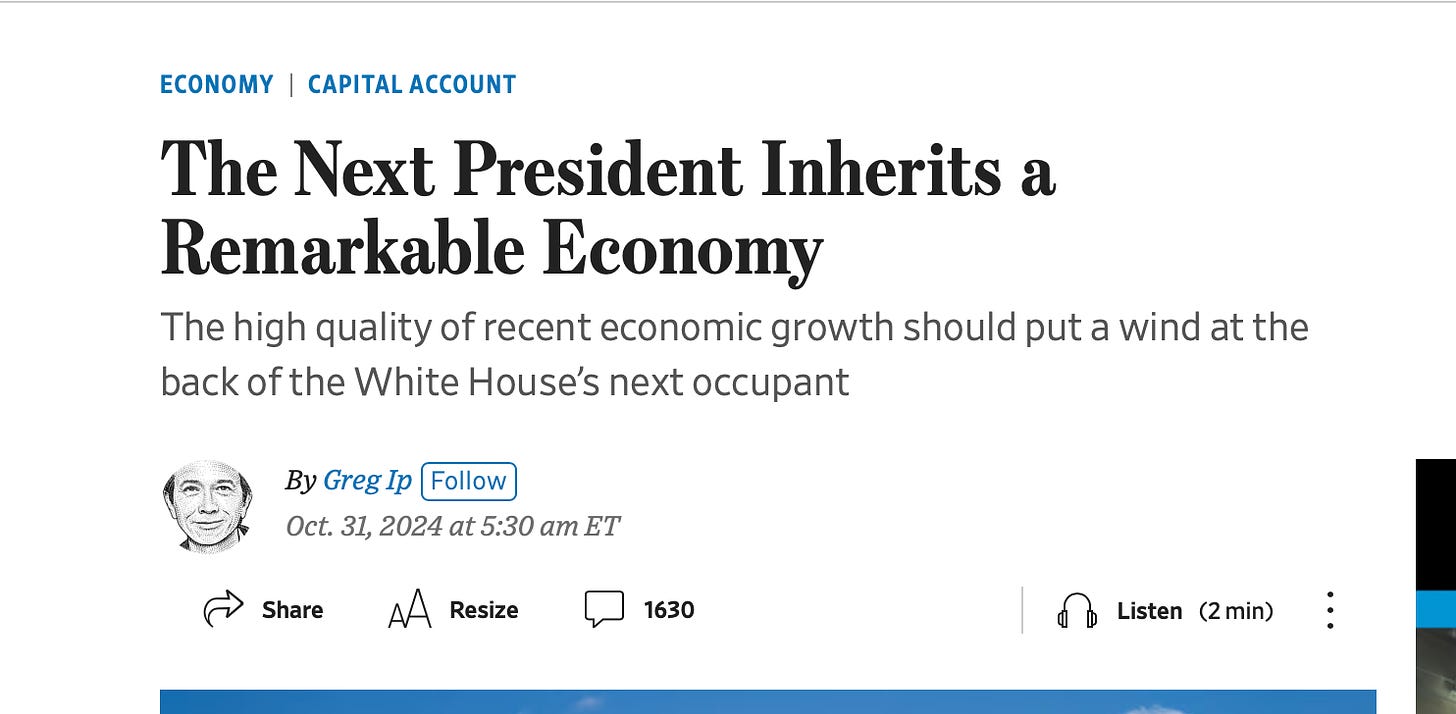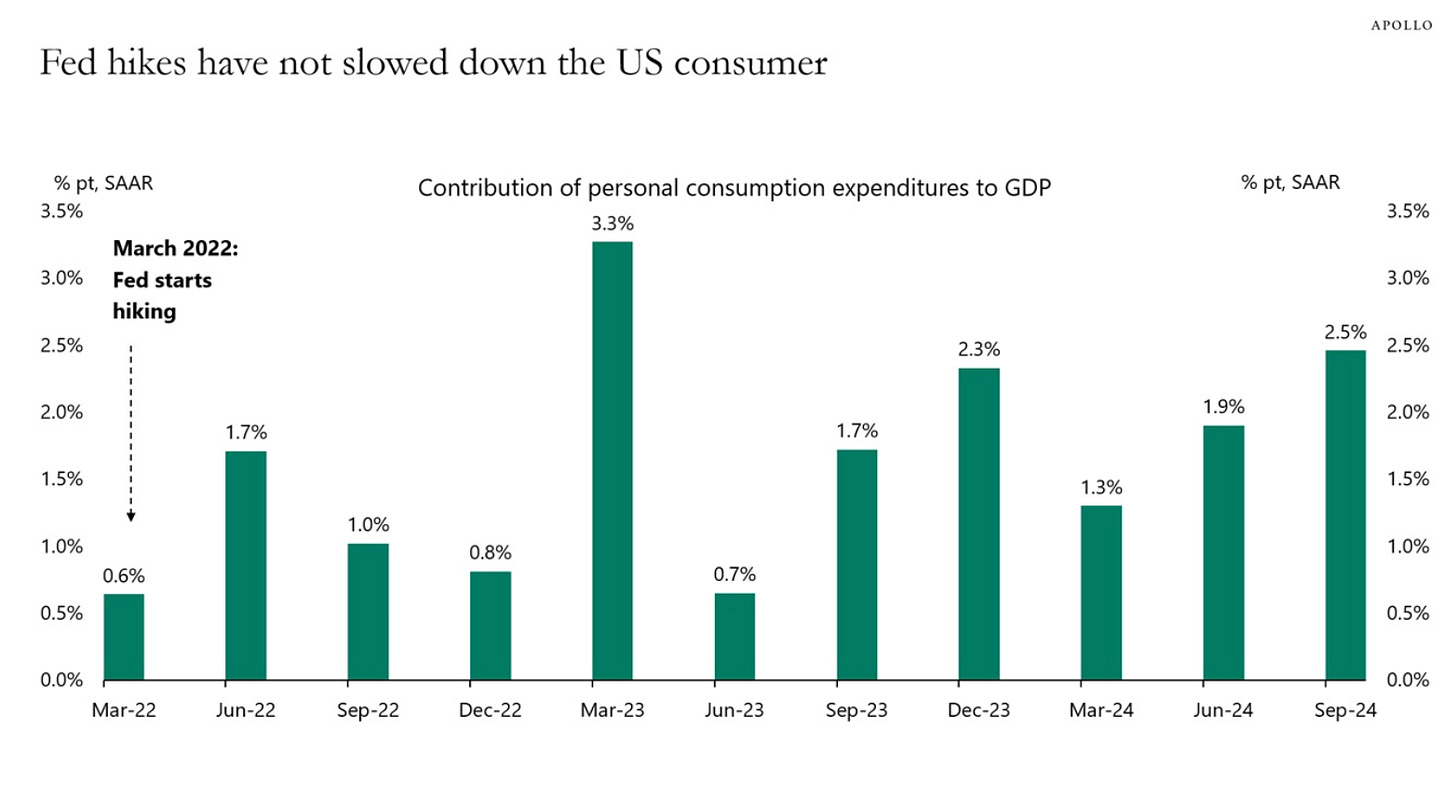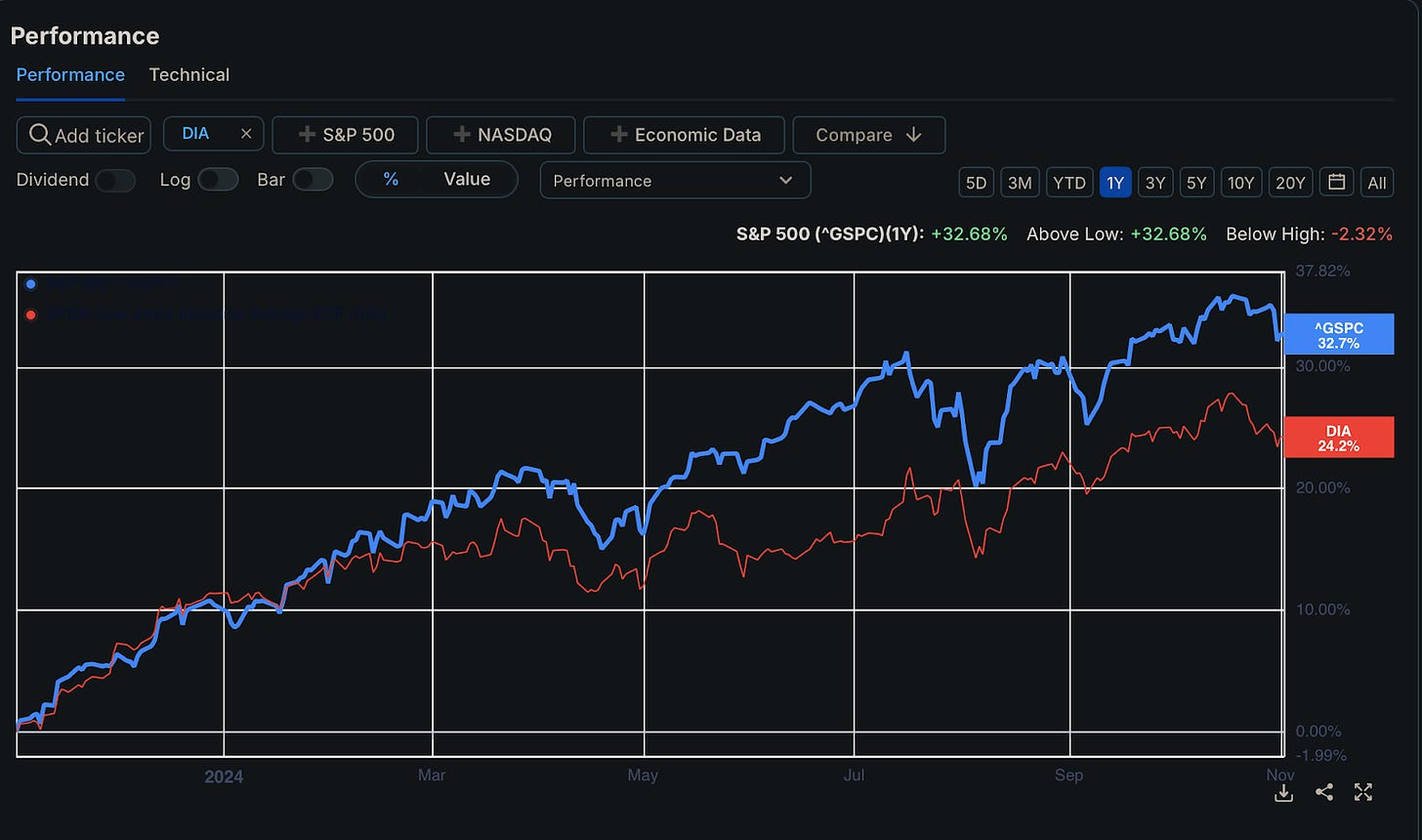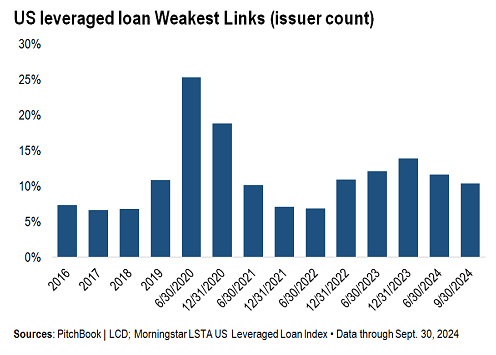💥Inexact💥
Exactech Inc., TGI Fridays Inc., Lumio Holdings Inc., Sunnova Energy International Inc. ($NOVA), Global Wound Care Medical Group PC & More.
The ironically-named United States of America (“U.S.A.”) is, once again, on the eve of the most consequential, epochal, historic, seminal, portentous elections in its 248-year history. Yeah, another one of those g*ddamn “humanity’s future is at stake” elections. Given the magnitude of the moment, you’d think there would be similarly consequential, epochal, historic, etc., activity in financial markets as investors handicap the apocalypse.
There’s been none of that.
Sure, October payrolls were a dismal 12k, but that’s all because of Hurricanes Helene and Beryl and the port strike. Ditto the miss in ISM Manufacturing (46.5% in October vs. 47.6% forecast). But consumer confidence rose to 108.7 from 99.2. Core PCE may have increased month over month — per Goldman Sachs ($GS) economists, due mostly to “residual seasonality in PCE components” (eg, airfares) — but it declined year over year, which is more important. One might even argue that a “narrative” is forming before our eyes. Per The Wall Street Journal:
Indeed, the economic statistics disseminated by government agencies certainly paint a “remarkable” picture of “growth” in a statistical sense. Whether it bears any resemblance to the economy that exists outside Federal mainframes is a different story. Our favorite economist Torsten Sløk of Apollo Global Management offers a rational theory for the economy’s strength: less sensitivity to interest rates, as consumers locked in low rates during the pandemic; the “structural boom” of AI/data center buildout; and an “easy fiscal policy” as a result of the CHIPS Act, the Infrastructure Act and defense spending. The Great American Consumer is in fine shape:
Bullishness abounds — even at historically high P/E levels:
So there’s been a bit of a dip in recent weeks. So what? The trend is the important thing. The hoary old Dow lagging the S&P 500? Not to fear: once Intel Corp. ($INTC) is out of the DJIA (despite its breakout on Friday) and Nvidia Corp. ($NVDA) is in, that gap will close in a matter of minutes. With interest rates set to decline some more later this week — yes, friendly reminder, there IS a Fed meeting RIGHT AFTER the election — there’s reason to suspect that as rates go down, outflows from lower-yielding money market funds and treasuries will eventually transpire and feed the equity beast. To the moon, we say! 🚀
You know who doesn’t say that? Warren Buffett. With 72% of the S&P having already reported earnings and EPS coming in at 14% in the aggregate, homeboy is nevertheless getting liquid AF. Here’s one interpretation:
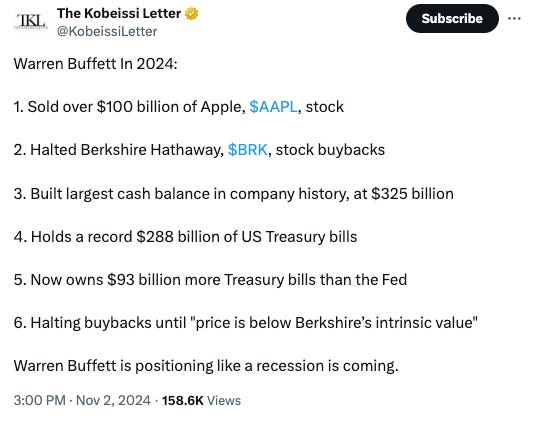
And here’s another:

Admittedly, both notions crossed our minds before we even saw these tweets. Who knows what’s really happening? Certainly not us but pardon the obvious: Warren is no spring chicken. He’s also no dummy. What is he (or are his acolytes) seeing that the market isn’t, 🤔?
What are the credit markets telling us? Spreads are tight. Like, historically tight. There’s very little fear in the high yield and investment grade markets. Which may, in fact, be reason enough to be fearful.
How about leveraged loans? There’s been $1 TRILLION of loans printed year to date. That’s 23% over last year, and 8% ahead of the prior record in set in ‘17:
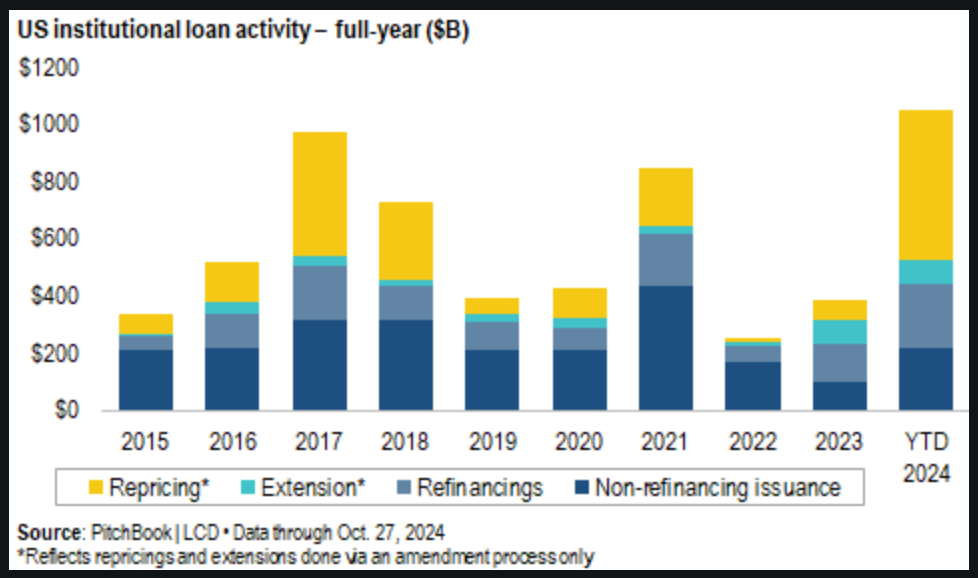
Around half of that trillion came from repricings, Pitchbook says, and there’s more to come: “With new-issue borrowing spreads hovering near multiyear lows, roughly 40% of all outstanding US leveraged loans have been repriced so far this year, and more borrowers are waiting in the wings.”
Still, FitchRatings says there are still names to follow in leveraged loan land:
“Ten issuers across eight sectors defaulted on $5.8 billion of leveraged loan debt in September, driving the TTM September default rate to 4.68%, up from 4.49% in August. Each default involved a highly levered issuer grappling with high interest expenses that pressured liquidity. This led to a missed interest payment in the cases of Mavenir Systems and American Rock Salt. Some issuers were also simultaneously facing weakening operational performance from lower demand for their services or lower-than-expected growth. This was the case for Digital Media Solutions, New Constellis and Pretium Packaging. Rising competition, inconsistent or weakening demand and the industry’s destocking headwinds in 2023 played a key role in the deterioration of operating performance for Polar US Borrower, LLC (CCC) and ASP Unifrax Holdings, Inc. (RD). Both chemical sector issuers completed distressed debt exchange (DDE) defaults.” (emphasis added)But, per S&P Global Ratings, the list of names is getting smaller and smaller. Lots of deals are getting done. Per Pitchbook:
“Record amend-and-extend activity, a proliferation of distressed liability management exercises and, increasingly, private credit lenders stepping in to meet refinancing needs have driven down the share of US loan issuer “Weakest Links” for a third consecutive quarter.
LCD’s Weakest Links count — a forerunner for potential default activity — includes companies rated B-minus or lower (excluding defaulted deals) by S&P Global Ratings that have a negative outlook or implication, and are therefore on the cusp of a downgrade to, or further into, the vulnerable triple-C category.
With financial conditions easing, and the US Federal Reserve cutting rates for the first time since 2020 during the period, the tally of these at-risk issuers tracked by LCD fell to 136 as of Sept. 30, down from 154 in Q2 and a post-pandemic high of 183 at the end of 2023.”They include this handy chart:
One deal that didn’t get done? Exactech Inc. The manufacturer and seller of medical implant devices that may or may not have caused thousands of people some serious medical problems was the lone constituent of the Morningstar LSTA US Leveraged Loan Index to default this past week. Not in that index? TGI Friday’s, though it, like Exactech, filed a chapter 11 bankruptcy this week — marking a big week by Ropes & Gray LLP, which represents both companies as legal counsel.
We cover both names and more below. Let’s dig in ⬇️.
💥New Chapter 11 Bankruptcy - Exactech Inc.💥
On October 29, 2024, FL-based Exactech Inc. and four affiliates (collectively, the “debtors”) filed chapter 11 bankruptcy cases in the District of Delaware (Judge Silverstein). The debtors are in the business of manufacturing and selling medical implant devices such as replacement hips, joints, shoulders and feet. Hopefully you haven’t had one of these surgeries and gotten one of these devices implanted because a primary factor in this bankruptcy filing is the fact that these devices have allegedly been faulty as-all-f*ck. Luckily, the debtors’ lead counsel, Ryan Preston Dahl of Ropes & Gray LLP, has not had one of these implants, despite his “brief football career,” a detail that Mr. Dahl felt absolutely compelled to share at the debtors’ first day hearing.* Cue the soundtrack Johnny!
Snark aside, the football career is pertinent because it’s very clear that blocking and tackling is going to be (and has already been) a huge part of Mr. Dahl’s assignment here. This situation has it all: lenders duking it out with private equity bros duking it out with plaintiffs’ attorneys. Strap your helmets on, folks.




